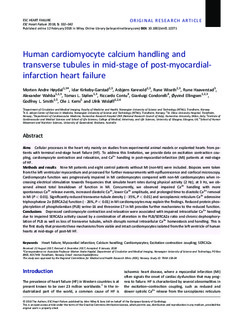| dc.contributor.author | Høydal, Morten | |
| dc.contributor.author | Karevold, Asbjørn | |
| dc.contributor.author | Garstad, Idar Kirkeby | |
| dc.contributor.author | Wiseth, Rune | |
| dc.contributor.author | Haaverstad, Rune | |
| dc.contributor.author | Stølen, Tomas | |
| dc.contributor.author | Contu, Riccardo | |
| dc.contributor.author | Condorelli, Gianluigi | |
| dc.contributor.author | Ellingsen, Øyvind | |
| dc.contributor.author | Smith, Godfrey L | |
| dc.contributor.author | Kemi, Ole J | |
| dc.contributor.author | Wisløff, Ulrik | |
| dc.date.accessioned | 2018-08-08T11:30:39Z | |
| dc.date.available | 2018-08-08T11:30:39Z | |
| dc.date.created | 2018-04-26T14:58:38Z | |
| dc.date.issued | 2018 | |
| dc.identifier.issn | 2055-5822 | |
| dc.identifier.uri | http://hdl.handle.net/11250/2508045 | |
| dc.description.abstract | Aims
Cellular processes in the heart rely mainly on studies from experimental animal models or explanted hearts from patients with terminal end‐stage heart failure (HF). To address this limitation, we provide data on excitation contraction coupling, cardiomyocyte contraction and relaxation, and Ca2+ handling in post‐myocardial‐infarction (MI) patients at mid‐stage of HF.
Methods and results
Nine MI patients and eight control patients without MI (non‐MI) were included. Biopsies were taken from the left ventricular myocardium and processed for further measurements with epifluorescence and confocal microscopy. Cardiomyocyte function was progressively impaired in MI cardiomyocytes compared with non‐MI cardiomyocytes when increasing electrical stimulation towards frequencies that simulate heart rates during physical activity (2 Hz); at 3 Hz, we observed almost total breakdown of function in MI. Concurrently, we observed impaired Ca2+ handling with more spontaneous Ca2+ release events, increased diastolic Ca2+, lower Ca2+ amplitude, and prolonged time to diastolic Ca2+ removal in MI (P < 0.01). Significantly reduced transverse‐tubule density (−35%, P < 0.01) and sarcoplasmic reticulum Ca2+ adenosine triphosphatase 2a (SERCA2a) function (−26%, P < 0.01) in MI cardiomyocytes may explain the findings. Reduced protein phosphorylation of phospholamban (PLB) serine‐16 and threonine‐17 in MI provides further mechanisms to the reduced function.
Conclusions
Depressed cardiomyocyte contraction and relaxation were associated with impaired intracellular Ca2+ handling due to impaired SERCA2a activity caused by a combination of alteration in the PLB/SERCA2a ratio and chronic dephosphorylation of PLB as well as loss of transverse tubules, which disrupts normal intracellular Ca2+ homeostasis and handling. This is the first study that presents these mechanisms from viable and intact cardiomyocytes isolated from the left ventricle of human hearts at mid‐stage of post‐MI HF. | nb_NO |
| dc.language.iso | eng | nb_NO |
| dc.publisher | Wiley | nb_NO |
| dc.rights | Navngivelse 4.0 Internasjonal | * |
| dc.rights.uri | http://creativecommons.org/licenses/by/4.0/deed.no | * |
| dc.title | Human cardiomyocyte calcium handling and transverse tubules in mid-stage of post-myocardial-infarction heart failure | nb_NO |
| dc.type | Journal article | nb_NO |
| dc.type | Peer reviewed | nb_NO |
| dc.description.version | publishedVersion | nb_NO |
| dc.source.journal | ESC Heart Failure | nb_NO |
| dc.identifier.doi | 10.1002/ehf2.12271 | |
| dc.identifier.cristin | 1581908 | |
| dc.description.localcode | © 2018 The Authors. ESC Heart Failure published by John Wiley & Sons Ltd on behalf of the European Society of Cardiology. This is an open access article under the terms of the Creative Commons Attribution License. | nb_NO |
| cristin.unitcode | 194,65,25,0 | |
| cristin.unitname | Institutt for sirkulasjon og bildediagnostikk | |
| cristin.ispublished | true | |
| cristin.fulltext | original | |
| cristin.qualitycode | 1 | |

